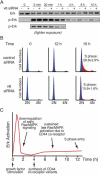A positive feedback loop couples Ras activation and CD44 alternative splicing
- PMID: 16818603
- PMCID: PMC1522067
- DOI: 10.1101/gad.1430906
A positive feedback loop couples Ras activation and CD44 alternative splicing
Abstract
The Ras signaling pathway is important in both cell proliferation and tumor progression. Alternatively spliced isoforms of CD44 containing variable exon 6 (v6) can serve as coreceptors for growth factor receptors that activate Ras. Here we use v6-specific small interfering RNA (siRNA) to investigate the role of CD44 alternative splicing in Ras signaling. We identify a positive feedback loop in which Ras signaling promotes CD44v6 splicing, and CD44v6 then sustains late Ras signaling, which is important for cell cycle progression. These results are the first demonstration of a positive feedback loop linking signaling-dependent alternative splicing to mitogenic progression.
Figures




References
-
- Bourguignon L.Y., Zhu H., Chu A., Iida N., Zhang L., Hung M.C. Interaction between the adhesion receptor, CD44, and the oncogene product, p185HER2, promotes human ovarian tumor cell activation. J. Biol. Chem. 1997;272:27913–27918. - PubMed
-
- Favata M.F., Horiuchi K.Y., Manos E.J., Daulerio A.J., Stradley D.A., Feeser W.S., Van Dyk D.E., Pitts W.J., Earl R.A., Hobbs F., et al. Identification of a novel inhibitor of mitogen-activated protein kinase kinase. J. Biol. Chem. 1998;273:18623–18632. - PubMed
Publication types
MeSH terms
Substances
LinkOut - more resources
Full Text Sources
Other Literature Sources
Miscellaneous
